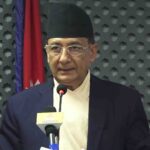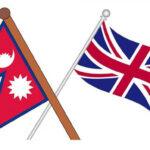Kathmandu, Aug 17 :
(Narayan Dhungana)
Data shows that the country has sufficient food reserve, but food imbalance due to disproportionate production and distribution posed a threat to food security in Nepal with 7.8 percent population at risk of a severe food crisis.
Minister for Agriculture and Livestock Development Mrigendra Singh Yadav said the existing food reserve is sufficient to meet the average daily food requirements for Nepalis, but still the risk of food insecurity prevails.
He was presenting the fact during a seminar entitled ‘Food Security in Nepal’ jointly organised by the National Security Council and the Nepali Army.
According to him, food intake habits and culture, people’s unequal access to food, food inaccessibility, lack of quality food, natural disasters and consequences, impact of climate change, artificial food shortage, COVID-19 and fluctuations of food prices in the national and international market have posed uncertainty in the domestic food supply chain.
Likewise, an exodus of youth force from the agricultural activities, pesticides attacks on crops and the increasing size of uncultivated land are additional challenges for keeping food security intact.
According to World Food Summit 1996, food security exists when all people, at all times, have physical, social and economic access to sufficient, safe and nutritious food that meets their dietary needs and food preferences for an active and healthy life.
The World Bank defines the situation when the calorie intake remains under 1,800 per day per person as the severe food insecurity and according to the WB definition, 7.8 percent of total population face a greater risk of severe food insecurity in Nepal.
An adult with normal health condition requires an intake of 2,200 calorie each day for an active life and the calorie consumption majorly depends on the availability of food.
The 15th five-year plan in Nepal states that 21 percent population in Nepal has still no access to sufficient food. It says that only 48.2 percent of the households are basically food secure.
The government data shows that during the last fiscal year (2078-79 BS), the food production in the country is 369 kilos per person and it is estimated to be 257 kilos after deducting seeds, preservation for animal feed and the loss during post-harvest stage.
The figure suggests the food production is enough to meet the daily minimum food requirements of the people.
In the fiscal year, 2078-79 BS, the annual food production in the country was 10 million 772 thousand metric tonnes and it was around 7,530,000 metric tonnes by deducing the seeds, livestock preservation and post-harvest stage loss.
As the report says country needs around 5 million 867 thousand metric tonnes of processed food to meet the food requirements of its population.
On the occasion, the Minister said, “The data about the availability of the food shows the quantity of food reserve is approximately 1,663,000 metric tons. Despite the food reserve at the national level, at the household level, around 21 still face the situation forcing them to limit their daily calorie intake below the requirements. As he assessed, imbalanced production and distribution push around 20 districts at the risk of food insecurity.
The time analysis of the past one decade shows that food reserve in the nation is good, except in the year 2015 that witnessed the major earthquake.
The import of large quantity of rice on the other hand is unexpected. The Central Bureau of Statistics’ Annual Household Survey Report, 2017 shows that the consumption of fine grain rice is on increasing trend. Domestic production of rice has not been able to meet the growing demand. However, opposed to this a large quantity of production of other cereals is being consumed. In terms of food and nutritional security, the contribution of crops like millet and buckwheat has still not come in the mainstream.
Seventy-seven percent of the daily total calorie requirement of a person should be supplied through plant-based food and materials while the rest should be supplied through animals, birds and fish. But the daily calorie requirement is not according to this, the Ministry of Agriculture and Livestock Development has pointed out. It is said 87 percent of the calorie requirement per person is derived from plant-based materials and the rest is derived from milk, dairy products, meat and egg.
Minister Yadav said that the statistics shows that from the production point of view, the country is self-sufficient on fish, meat and egg while it is close to this in milk. He reiterated that the Ministry is giving special stress on food security in terms of increasing the production and supply of animal-based food for nutritional security.
It is necessary to put in extra investment for expanding the irrigation facility, the availability of improved varieties of seeds and breeds and modernization as well as commercialization of agriculture for production growth.
Also required is collaboration among the three tiers of the government, NGOs, private organisations and development partners for research, technology expansion and infrastructure development to face the challenges seen in the food and nutrition security, Minister Yadav pointed out.
Defence Secretary and the National Security Council Secretariat coordinator Kiran Raj Sharma said this is the first seminar of its kind on contemporary topic. Stating that the issue of food security is not only linked to human security but is also directly linked to overall development, he said this programme has been organised in this light.
The World Food Summit organized in 1974 had acknowledged that food is the basic requirement and stressed on maintaining a balance regarding its quantity, price and supply. The World Food Summit held in 1996 in Rome stated that it can be considered the status of food security has been achieved only if every person has physical and economic access to healthy and nutritious food as per his/her requirement.
Secretary Sharma said it is regrettable that Nepal has not been able to produce the required quantity of food grain despite being predominantly an agrarian country. He added that a large number of populations in the country are deprived of food security due to the sustenance and traditional agriculture system, disparity in the availability and distribution of agricultural land, the complications related to the structure of cultivable land and over-dependence on import in agriculture.
Sixty percent of the country’s population is dependent on agriculture while its contribution to GDP is 32 percent. Statistics show that there is shortage of 600 thousand metric tonnes food grain in Nepal annually.
Experts have come to the conclusion that food security in Nepal is also affected due to factors like COVID-19 global pandemic, the Russia-Ukraine war and its adverse impact on the supply of food grains and fuel and the change in the policy of import and export of food grains adopted by various countries in the aftermath of the Russia-Ukraine conflict, among others.
(RSS)



